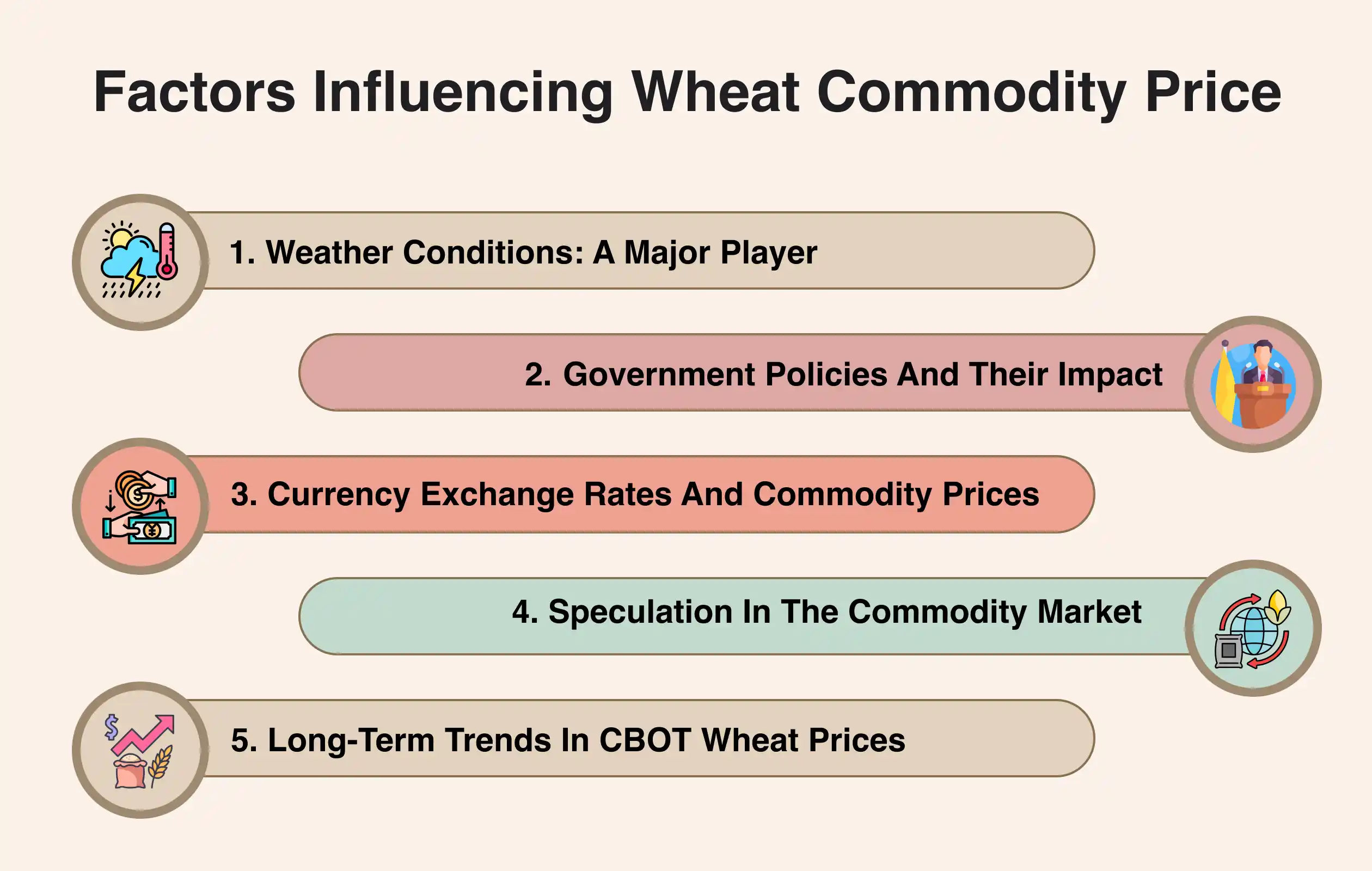How Global Wheat Supply Chains Influence CBOT Wheat Prices | PriceVision

The wheat market is a crucial part of the global commodity market, impacting economies and food security worldwide. Understanding and predicting the CBOT Wheat prices is vital, as the Chicago Board of Trade (CBOT) is a significant global exchange where wheat prices are set, influencing markets far beyond the United States. This blog will delve into how global wheat supply chains affect CBOT Wheat prices and their implications for the global wheat market.
Introduction to CBOT Wheat Prices
The Chicago Board of Trade (CBOT) is one of the oldest and most renowned commodity exchanges, dealing in a variety of goods, including wheat. CBOT Futures contracts, which are agreements to buy or sell a specified quantity of wheat at a predetermined price on a future date, control wheat prices. These prices are seen as a global benchmark, affecting wheat prices worldwide.
The Role of Global Supply Chains in the Wheat Market
Wheat is a staple grain worldwide, and its market dynamics are deeply influenced by the intricacies of global supply chains. Major wheat-producing countries such as the United States, Russia, Ukraine, and Canada play critical roles in these supply chains, and any disruptions in these regions can have far-reaching effects on CBOT Wheat prices.
Global Supply and Demand Dynamics
The global supply and demand for wheat are key factors driving CBOT Wheat prices. A surplus in global wheat production typically leads to a decrease in prices, while a shortage results in higher prices. For instance, if major wheat-producing regions like China, the U.S., Russia, or Ukraine experience bumper crops, it can lead to lower CBOT Wheat prices, impacting markets globally.
When bad weather, political problems, or transportation issues affect these regions, it can reduce the supply of wheat and make prices go up on the CBOT. Because the world is so connected, problems in one area can spread and impact wheat prices everywhere.
|
Market |
%
of Global Production |
Total
Production (2023/2024, Metric Tons) |
|
China |
17% |
136.59 Million |
|
India |
14% |
110.55 Million |
|
Russia |
12% |
91.5 Million |
|
United
States |
6% |
49.31 Million |
|
Canada |
4% |
31.95 Million |
Source: USDA Foreign Agricultural Services
https://fas.usda.gov/data/production/commodity/0410000
Factors Influencing Wheat Commodity Prices

1. Weather Conditions: A Major Player
Weather conditions are crucial in determining wheat yields and, by extension, CBOT Wheat prices. Adverse weather conditions such as droughts, floods, or unseasonal rains can severely impact wheat production. For example, a drought in the U.S. Midwest can reduce wheat yields, leading to higher commodity prices globally. This, in turn, can raise wheat prices worldwide.
Climate change also introduces long-term uncertainties into the global wheat supply chain, potentially leading to more frequent and severe weather disruptions. As a result, CBOT Wheat prices are increasingly influenced by climate-related risks that affect production and supply stability.
2. Government Policies and Their Impact
Government policies, both domestically and internationally, can significantly impact CBOT Wheat prices. Policies related to minimum support prices, procurement, and export-import restrictions play a vital role in determining wheat prices. Globally, decisions like export bans from major wheat-producing countries can reduce supply, driving up CBOT Wheat prices and affecting markets around the world.
Trade policies and international agreements also play a significant role. For instance, tariffs and trade barriers can disrupt the smooth flow of wheat across borders, impacting global supply chains and influencing CBOT Wheat prices.
3. Currency Exchange Rates and Commodity Prices
The value of the U.S. dollar plays a critical role in the global commodity market. Since wheat is traded globally in U.S. dollars, fluctuations in the dollar's value can affect CBOT Wheat prices. A stronger dollar makes wheat more expensive for buyers using other currencies, potentially reducing global demand and lowering prices. Conversely, a weaker dollar can increase demand and push prices higher.
4. Speculation in the Commodity Market
Speculation is another significant factor that can influence CBOT Wheat prices. Speculators in the commodity market buy and sell futures contracts based on their expectations of future price movements. If they believe that wheat prices will rise due to factors like poor weather or increased demand, they may buy large quantities of futures contracts, driving up CBOT Wheat prices. This speculative activity can create price volatility, impacting the wheat market globally.
5. Long-term Trends in CBOT Wheat Prices
Over the years, Wheat prices have shown both short-term volatility and long-term trends. While prices may fluctuate due to seasonal factors, long-term trends could be influenced by changes in global food demand, climate change, and technological advancements in agriculture.
How to Predict CBOT Wheat Commodity Prices
Predicting Wheat prices is a complex task that involves analyzing a multitude of factors. However, several methods and tools can help market participants make informed predictions.

1. Fundamental Analysis
Fundamental analysis involves examining the underlying factors that affect supply and demand, such as weather conditions, government policies, and global economic trends. By understanding these factors, one can calculate predictions about future Wheat prices. For example, if weather forecasts predict a poor harvest in a major wheat-producing region, it may indicate a potential rise in prices.
2. Technical Analysis
Technical analysis involves studying historical price data and market trends to predict future price movements. Analysts use charts and various indicators to identify patterns and trends that suggest where Wheat prices might be headed. For instance, if a price chart shows a consistent upward trend, it may indicate that prices will continue to rise in the short term.
3. Machine Learning and AI
With advancements in technology, machine learning, and artificial intelligence are increasingly being used to predict commodity prices, including Wheat prices. These technologies can analyze vast amounts of data and identify patterns that may not be visible to human analysts. For example, AI algorithms can process weather data, market trends, and historical prices to provide more accurate predictions.
One such platform leveraging these technologies is PriceVision. It is an advanced commodity price forecasting and prediction tool using AI and data analytics. By processing extensive datasets, PriceVision offers accurate insights into Wheat prices, helping traders and farmers make informed decisions. Its predictions consider various factors, including global supply and demand, weather patterns, and market sentiment, making it a valuable tool in navigating the complexities of the commodity market.
4. Market Sentiment Analysis
Analyzing market sentiment entails determining the market's general attitude. If market participants are optimistic about the future, prices may rise, and vice versa. Market sentiment can be influenced by news events, economic data, and geopolitical developments. For example, news of a trade deal between major wheat-exporting countries could boost market confidence and drive up Wheat prices.
Conclusion
Predicting Wheat prices is a challenging but essential task for anyone involved in the wheat market. By understanding the factors that influence these prices and using the right tools and methods, market participants can make informed decisions that benefit their operations.
In conclusion, the commodity market is dynamic and ever-changing, and staying informed is key to success. Whether you are a farmer, trader, or policymaker, understanding and predicting CBOT Wheat prices can give you a competitive edge in the wheat market. Platforms like PriceVision, which leverage AI and data analytics, can further enhance your ability to make informed decisions, helping you navigate the ever-changing landscape of the commodity market.
FAQs
1. What Factors Influence CBOT Wheat Prices?
CBOT Wheat prices are influenced by various factors, including global supply and demand dynamics, weather conditions, government policies, currency exchange rates, and market speculation.
2. How do global supply chains impact wheat prices?
Global supply chains impact wheat prices by affecting the availability and cost of wheat on the market. Disruptions in major wheat-producing regions, such as bad weather or political instability, can reduce supply and drive up prices.
3. Can AI Tools Predict Wheat Prices Accurately?
Yes, AI tools can predict wheat prices with a good degree of accuracy by analyzing vast amounts of historical data, market trends, weather patterns, and other relevant factors.